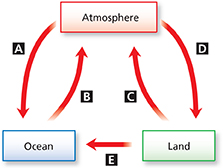CHAPTER 23 Assessment
Interactive Textbook with assessment at PHSchool.com 
Reviewing Content
Choose the letter that best answers the question or completes the statement.
The greatest supply of fresh water on Earth is found in
the oceans.
glaciers.
the atmosphere.
rivers and lakes.
The release of water into the atmosphere by plants is called
transpiration.
evaporation.
precipitation.
sublimation.
Which of the following is NOT an example of mechanical weathering?
frost wedging
oxidation
plucking
abrasion
The type of mass movement that occurs when soil gradually moves down a slope is called (a)
landslide.
mudflow.
creep.
slumping.
Which of the following is the most important factor influencing the ability of a stream to erode?
salinity
depth
speed
volume of flow
As rivers flow from mountains to the ocean, they tend to
move more quickly.
get narrower.
get steeper.
become less steep.
A feature formed by chemical weathering is
a cave.
a dune.
loess.
till.
The sediment deposited at the front of a glacier is called a
stalagmite.
slump.
moraine.
meander.
Which feature is the result of wind deposition?
horn
delta
sand dune
cirque
Absolute ages of rocks are found from
the law of superposition.
the relative order of rock layers.
index fossils.
radioactive dating.
Understanding Concepts
Why is less than 1 percent of Earth's water available for human use?
Describe the path that one rain drop would take through the water cycle.
What is the role of gravity in the water cycle?
A simplified diagram of the water cycle is shown below. Identify the process associated with the movement of water in each arrow.
Explain how the saturated zone is related to the water table. How might the water table change during a drought?
Give one example of mass movement that occurs quickly, and one example of mass movement that occurs slowly.
What is saltation?
Why are caves most often found in regions where the bedrock is composed of limestone?
How can you tell if a mountain valley was formed by a stream or by a glacier?
How does the wind-driven process of deflation alter the surface?
How are waves responsible for both erosion and deposition?
What is an index fossil?





